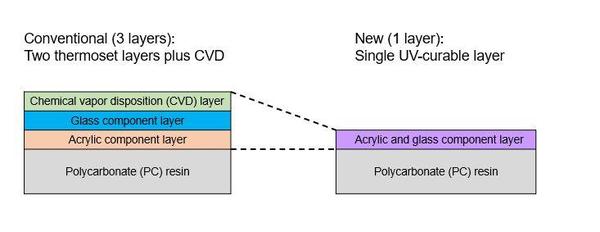Toyota Industries Corporation Develops World’s First*1 Hard Coating Material for Plastic Vehicle Windshields That Meets the International Standard*2 with a Single Coat
—Expanding Scope of Use for Plastic Glazing and Contributing to a Low-Carbon Society through Lighter Vehicles—
|
Toyota Industries Corporation (President: Koichi Ito; "Toyota Industries") has developed the world's first high-hardness hard coating material for plastic glazing that meets the relevant international standard for abrasion resistance (UN/ECE R43 Class L requirements) with a single coat. The material is for application to vehicle windshields, front door windows and other areas related to a driver's field of vision. The new UV-curable*5 hard coating material can be applied in a single coat to save energy and reduce costs. Compared to conventional two-coat thermosetting materials plus chemical vapor disposition (CVD)*6, it reduces CO2 emissions in the coating process by about 80%*7 and coating costs by about 40%*8.
As the automotive industry works to realize carbon neutrality by 2050, weight reduction of vehicle bodies is becoming increasingly important as a way of extending cruising ranges. Plastic glazing made of polycarbonate resin are about half the weight of comparable glass windows, while also being harder to break and easier to thermoforming. In addition to enabling weight reduction, this material is gaining a lot of attention for its contributions to vehicle safety and design.
Depending on where they are used, plastic glazing are subject to international standards for abrasion resistance, with high performance required particularly in areas related to a driver's field of vision, such as windshields. A three-layer coating was mainly used in the past to meet these requirements, with the conventional process applying two thermoset coats (one acrylic component and one glass component) separately on a polycarbonate resin base, and then adding a single layer of dense, hard glass using CVD. However, this posed challenges in terms of energy consumption and high costs.
This newly developed hard coating material employs a world-first technology that enables it to meet Class L requirements with a single coat. To ensure the upper coat is as hard as possible after the UV curing process, the material comprises an optimal blend of an acrylic component for high flexibility and a glass component for hardness. As a single UV-curable coating for single-layer application, it has dramatically reduced energy consumption and costs. Lexus is using plastic glazing with this new hard coating material for the windshields of its first ROV*3 equipped with hydrogen-fueled engines. Data that it acquires through an ROV-based customer experience program will be fed back into developing the technology for practical application.
Toyota Industries began developing plastic glazing for automotive use in the 1990s. It now has over 20 years of experience in development, and application to mass production vehicles, of proprietary hard coating materials with outstanding abrasion and weather resistance, and manufacturing processes that balance quality and cost. Going forward, it will continue to develop optimal plastic glazing for future mobility while contributing to a low-carbon society through vehicle lightweighting.
| *1, 7, 8: | Toyota Industries research |
| *2: | Abrasion resistance requirements for windows related to a driver's field of vision as part of the UN/ECE R43 regulation for safety glazing materials on vehicles |
| *3: | The ROV is a concept vehicle featuring excellent response and an exhilarating engine sound that stimulates the senses. By venturing into places where even off-road vehicles cannot go, it aims to offer an enjoyable driving lifestyle by interacting and coexisting with nature |
| *4: | Details to be announced |
| *5: | A material that hardens when exposed to ultraviolet (UV) light, enabling faster hardening and more efficient production compared to thermoset materials |
| *6: | A method of supplying a source gas containing components of a film and using a chemical reaction to deposit a film on the surface of a substrate |
Layer structure of Plastic Glazing


